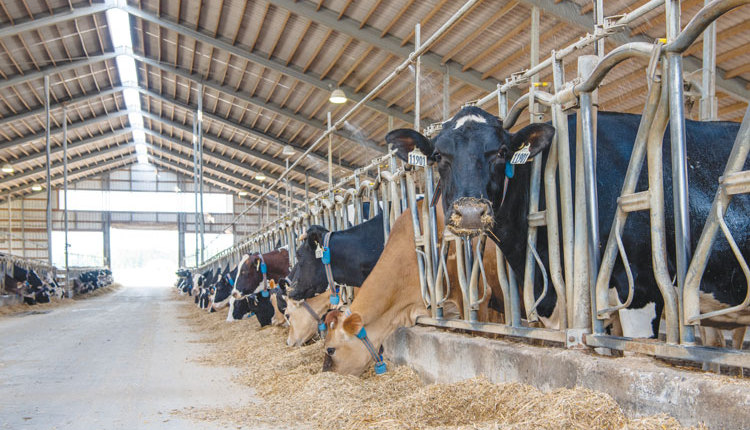
Money spent on proven diet strategies for transition cows usually has a high payback. How successful is transition on your farm? Can it be better? Dairy cows undergo huge metabolic challenges during the transition period. Is there some new approach that you should consider today to help your cows have a better start to their lactation?
Different energy needs
The high energy needs of fresh cows combined with their lower dry matter intake results in an energy deficit. Today’s genetically superior cows are designed to use some nonesterified fatty acids (NEFA) generated from body fat to supply a portion of their needed energy. In the liver, NEFA is converted to energy and acetate. If propionate (primarily from rumen fermented starch) is available at the liver, the acetate is also converted into energy for the cow. If not, the acetate is converted into ketones, which further depress intake.
Insulin is a hormone made in the pancreas. When insulin binds to receptors in the cow’s cells, blood glucose can be used for energy. For several weeks after calving, insulin levels are low and the sensitivity of the cow’s cells to insulin is poor.
Stress and inflammation reduce insulin sensitivity, and fat cows have even lower insulin sensitivity. These situations boost fat mobilization and blood NEFA levels. Blood beta-hydroxybutyrate (BHB) levels indicate a cow’s metabolic response to a negative energy balance situation where fat is being mobilized. Higher NEFA and BHB are associated with lower milk production as well as poor reproduction.
Chromium is known to raise the sensitivity of body tissues to insulin to help improve the use of blood glucose for energy and reduce blood NEFA. When researchers at Washington State University supplemented chromium from 21 days before calving to 35 days in milk, dry matter intake and milk production rose from 97 pounds per cow per day to 103 pounds per cow per day during the time from one to 90 days in milk.
Palm fat (palmitic acid; C16 fatty acids) added to the fresh cow diet during the first three weeks of lactation has improved milk and milkfat yields. However, it has also lowered insulin levels while raising body fat mobilization.
Chromium plus palm fat
In a recent Michigan State University study, cows from one to 24 days in milk were fed one of four treatment diets: a control diet, supplemental chromium (0.45 mg chromium per kg of diet dry matter), supplemental palm fat (1.5% of diet dry matter), or both chromium and palm fat. From 25 to 56 days in milk, all cows were fed the same diet without added chromium or palm fat to see if cow responses persisted after supplementation stopped.
From one to 24 days in milk, supplemental palm fat raised milk fat yield and energy-corrected milk (ECM) while chromium bolstered milk and milk protein yields. There were interactions associated with supplementing both chromium and palm fat together. Treatments had no significant effects on dry matter intake, body weight loss, NEFA, or BHB. However, NEFA and BHB levels were numerically lower when chromium was fed.
From 25 to 56 days in milk, cows that had been fed chromium continued to produce more milk and milk protein, but not more energy corrected milk (ECM). The positive effects of palm fat did not persist after supplementation was stopped at 24 days in milk.
Identify energy sources
Although I am hopeful that commercial dairies can get positive responses with supplemental chromium and palm fat, I never rely on one quick ration fix. Great transition cow comfort will promote higher dry matter intake. Provision of dietary energy is still a high priority, as well as improving calcium status and having optimal body condition at the time of calving.
Consider the following primary energy sources included in your fresh cow ration:
Digestible fiber: In early lactation, cows will have the greatest response to a highly digestible fiber that provides more energy. With higher fiber digestibility, plant cells take up less space in the rumen and pass from the rumen more quickly, allowing greater intake. Cows also spend less time eating and ruminating per pound of fiber when it is more digestible. Provide fresh cows with highly digestible fiber, making sure to still feed sufficient dietary physically effective fiber and undigestible fiber for proper rumen function.
Digestible starch: Grain in the manure is a sign that it did not provide energy for the cow. Smaller grain particles allow the rumen microbes to have more surface area to grab onto and digest grain before it passes out of the cow. Therefore, grinding targets starch digestibility. Less starch will be digested when corn silage is too dry, improperly processed, or if it has been fermented for less than four months.
Sugar: Research and field experience indicate that dietary sugar should be between 6% and 8% of diet dry matter. Sugar can raise total dietary energy because it is highly digestible. By replacing some dietary starch with sugar, there is less concern that excessive oxidation of propionate from starch in the liver will reduce dry matter intake in the fresh cow. Finally, sugars can help to control rumen acidity. Canadian researchers replaced corn grain with sugar to produce diets containing either 3% or 6% sugar. The high sugar diets resulted in a higher daily minimum rumen pH (5.61 versus 5.42) as well as a higher mean rumen pH (6.30 versus 6.17).









